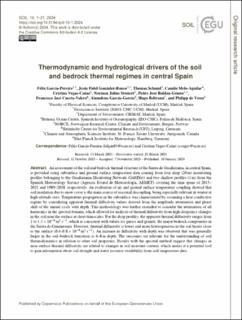| dc.contributor.author | García-Pereira, Félix | |
| dc.contributor.author | Gonzalez-Rouco, Jesus Fidel | |
| dc.contributor.author | Schmid, Thomas | |
| dc.contributor.author | Aguilar, Camilo Andres Melo | |
| dc.contributor.author | Vega-Cañas, Cristina | |
| dc.contributor.author | Steinert, Norman | |
| dc.contributor.author | Roldán-Gómez, Pedro José | |
| dc.contributor.author | Cuesta-Valero, Francisco José | |
| dc.contributor.author | García-García, Almudena | |
| dc.contributor.author | Beltrami, Hugo | |
| dc.contributor.author | de Vrese, Philipp | |
| dc.date.accessioned | 2024-02-07T11:55:09Z | |
| dc.date.available | 2024-02-07T11:55:09Z | |
| dc.date.created | 2023-12-05T11:02:41Z | |
| dc.date.issued | 2024 | |
| dc.identifier.citation | SOIL. 2024, 10 (1), . | en_US |
| dc.identifier.issn | 2199-3971 | |
| dc.identifier.uri | https://hdl.handle.net/11250/3116159 | |
| dc.description.abstract | An assessment of the soil and bedrock thermal structure of the Sierra de Guadarrama, in central Spain, is provided using subsurface and ground surface temperature data coming from four deep (20 m) monitoring profiles belonging to the Guadarrama Monitoring Network (GuMNet) and two shallow profiles (1 m) from the Spanish Meteorology Service (Agencia Estatal de Meteorología, AEMET) covering the time spans of 2015–2021 and 1989–2018, respectively. An evaluation of air and ground surface temperature coupling showed that soil insulation due to snow cover is the main source of seasonal decoupling, being especially relevant in winter at high-altitude sites. Temperature propagation in the subsurface was characterized by assuming a heat conductive regime by considering apparent thermal diffusivity values derived from the amplitude attenuation and phase shift of the annual cycle with depth. This methodology was further extended to consider the attenuation of all harmonics in the spectral domain, which allowed for analysis of thermal diffusivity from high-frequency changes in the soil near the surface at short timescales. For the deep profiles, the apparent thermal diffusivity ranges from 1 to m2 s−1, which is consistent with values for gneiss and granite, the major bedrock components in the Sierra de Guadarrama. However, thermal diffusivity is lower and more heterogeneous in the soil layers close to the surface (0.4– m2 s−1). An increase in diffusivity with depth was observed that was generally larger in the soil–bedrock transition at 4–8 m depth. The outcomes are relevant for the understanding of soil thermodynamics in relation to other soil properties. Results with the spectral method suggest that changes in near-surface thermal diffusivity are related to changes in soil moisture content, which makes it a potential tool to gain information about soil drought and water resource availability from soil temperature data. | en_US |
| dc.description.abstract | Thermodynamic and hydrological drivers of the subsurface thermal regime in Central Spain | en_US |
| dc.language.iso | eng | en_US |
| dc.rights | Navngivelse 4.0 Internasjonal | * |
| dc.rights.uri | http://creativecommons.org/licenses/by/4.0/deed.no | * |
| dc.title | Thermodynamic and hydrological drivers of the subsurface thermal regime in Central Spain | en_US |
| dc.title.alternative | Thermodynamic and hydrological drivers of the subsurface thermal regime in Central Spain | en_US |
| dc.type | Journal article | en_US |
| dc.type | Peer reviewed | en_US |
| dc.rights.holder | © Author(s) 2024 | en_US |
| dc.description.version | publishedVersion | en_US |
| cristin.ispublished | true | |
| cristin.fulltext | original | |
| cristin.qualitycode | 1 | |
| dc.identifier.doi | 10.5194/soil-10-1-2024 | |
| dc.identifier.cristin | 2209051 | |
| dc.source.journal | SOIL | en_US |
| dc.source.volume | 10 | en_US |
| dc.source.issue | 1 | en_US |
| dc.source.pagenumber | 21 | en_US |

